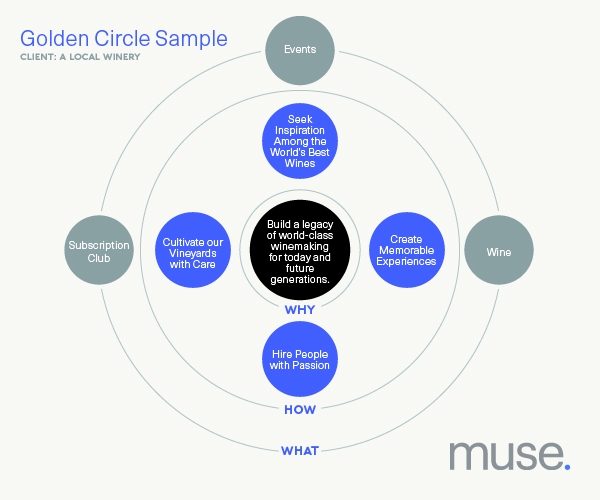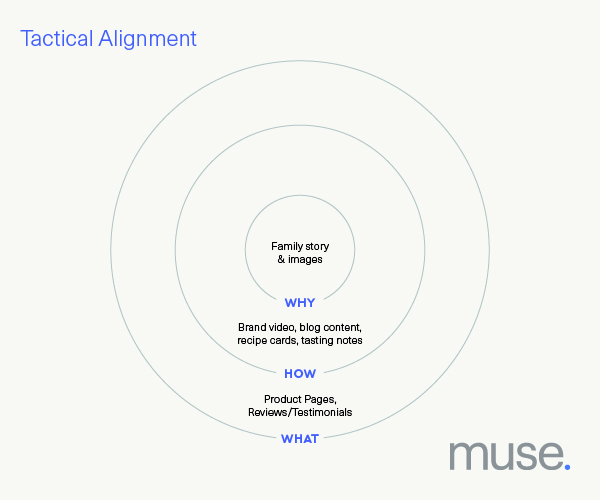Build a Better Content Plan from the Inside Out
Content planning sometimes feels like trying to find the best spot to fish in an expansive blue ocean. With so many angles to hit – product insights, industry expertise, case studies, customer testimonials, videos, etc. – where do you start?
At Muse (not MarketMuse, just Muse, a brand & content consultancy), we believe a successful content strategy aligns with a well-organized brand narrative. When content choices ladder up to a central brand position, the content serves a greater purpose beyond short-term visibility. It builds brand equity and enhances value perception in the minds of your buyers.
So before effective content planning can begin, the brand positioning process must be complete. Let’s take a closer look at a strategic exercise that helps you find the synergies between your brand and content aspirations.
The Golden Circle method
My agency leans on Simon Sinek and his Golden Circle Methodology as a straightforward foundation to architect an effective content kingdom.
In a nutshell, the Golden Circle philosophy stresses that people don’t buy WHAT you do; they buy WHY you do it. Sure, your audience may buy a product or service to address an immediate need, but that doesn’t mean they trust you or plan to purchase again. You earn their loyalty when they connect at an emotional level, with your WHY – your core purpose and values – and HOW you achieve them.
A strong content ecosystem bridges the gap between this brand narrative and your audience. Here are three steps to planning content that demonstrates a strong brand narrative.
Step #1: Build your own Golden Circle
Define your own WHAT, HOW and WHY. When organizing narrative in this way, brands often have conflicting thoughts on how to categorize revenue centers or distill advantages into a few strong actions. Use these tips as guidelines to build a powerful circle.

WHAT: The products or services you sell.
- To qualify as a WHAT, the product/service needs to be a revenue center for the business.
- If the brand has many offerings, categorize by collection.
- The WHATs may change with market demand, but any addition must be true to the HOWs and WHY.
HOW: The actions you take to stay competitive.
- Marketers often refer to this layer as unique selling propositions
- Look for clues in these areas: People, processes, sourcing and experience.
- Start your how statements with a verb to underscore action.
WHY: The brand’s purpose or “reason for being.”
- Your purpose should be mutually beneficial to you and your buyers (i.e. “making profit for shareholders” is not an acceptable purpose.)
- The statement needs to be authentic today, not aspirational for the future.
- It should rarely, if ever, change. Consistency is key.
Step #2: Plan content for each layer
These tactical ideas demonstrate how to create alignment between your Golden Circle elements and content plan.
All tactics should be considered when building a brand from the ground up – you need to address every layer. Established companies with more confidence in their sales numbers often focus on amplifying thought leadership topics to best express their WHY.

WHAT: Sales support
Low-funnel consideration stage.
- Sell sheets
- Product descriptions
- Case studies
- Customer testimonials
HOW: Brand stories
Mid-funnel education stage.
- Brand videos
- Case studies
- Employee stories
- Press releases
WHY: Thought leadership
Top-funnel discovery stage.
- How-to resources
- Blogs
- Whitepapers
- Webinars
Step #3: Evaluate the external landscape
As we know, content planning from the inside out is only half the battle. To ensure your topics resonate with audiences – especially those crafted for HOW/WHY categories – it’s time to evaluate external insight on performance trends and audience interests. Resources, like MarketMuse, are valuable to define gaps and opportunities for your focused perspective to shine.
If you build a content plan exclusively around what audiences want to hear, you risk disconnect from brand. Or worse, an ongoing pivot that leaves audiences confused instead of craving more. Effective content strategy lives in the overlap between internal narrative and external interests to express a consistent set of values at every turn.
As a brand advisor and content marketer, Jackie Bebenroth helps clients find their brand voice…and shout it from the rooftops with clarity, confidence and purpose. At Muse, she facilitates strategic communication sessions to set the course for powerful messaging along the buyer journey. Her work, ranging from local restaurant branding to six-figure global initiatives, has flown her around the country to speak on the fine art of positioning and content marketing.
Professional accolades include Content Marketing Institute’s Content Marketing Leader of the Year, American Advertising Federation’s 40 Under 40 Award, a SXSW Interactive Finalist award, and multiple project-based Content Marketing Awards.
You can connect with Jackie on LinkedIn.